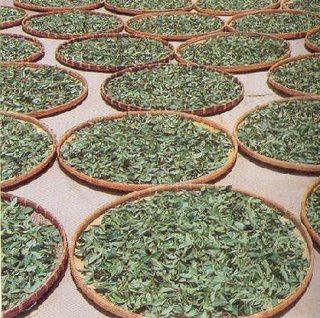Tea Production in China
 A new tea plant Production in China must grow for five years before its leaves can be picked and, at 30 years of age, it will be too old to be productive. The trunk of the old plant must then be cut off to force new stems to grow out of the roots in the coming year. By repeated rehabilitation in this way, a plant may serve for about l00 years.
A new tea plant Production in China must grow for five years before its leaves can be picked and, at 30 years of age, it will be too old to be productive. The trunk of the old plant must then be cut off to force new stems to grow out of the roots in the coming year. By repeated rehabilitation in this way, a plant may serve for about l00 years.For the fertilization of tea gardens, soya-bean cakes or other varieties of organic manure are generally used, and seldom chemical fertilizers. When pests are discovered, the affected plants will be removed to prevent their spread, and also to avoid the use of pesticides.
The season of tea picking depends on local climate and varies from area to area. On the shores of the West Lake in Hangzhou, where the famous green tea Longjing (Dragon Well) comes from, picking starts from the end of March and lasts through October, altogether 20-30 times from the same plants at intervals of seven to ten days. With a longer interval, the quality of the tea will deteriorate.
The new leaves must be parched in tea cauldrons. This work, which used to be done manually, has been largely mechanized. Top-grade Dragon Well tea, however, still has to be stir-parched by hand, doing only 250 grams every half hour. The tea-cauldrons are heated electrically to a temperature of about 25 C or 74 F. It takes four pounds of fresh leaves to produce one pound of parched tea.
The best Dragon Well tea is gathered several days before Qingming (Pure Brightness, 5th solar term) when new twigs have just begun to grow and carry "one leaf and a bud." To make one kilogram (2.2 lbs) of finished tea, 60,000 tender leaves have to be plucked. In the old days Dragon Well tea of Chinese tea this grade was meant solely for the imperial household; it was, therefore, known as "tribute tea".
For the processes of grinding, parching, rolling, shaping and drying other grades of tea various machines have been developed and built, turning out about 100 kilograms of finished tea an hour and relieving the workers from much of their drudgery.
[ Source : from chinaculture.org ]





























0 Comments:
Post a Comment
<< Home